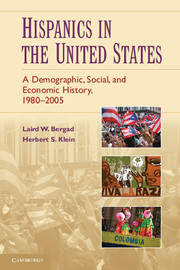Book contents
- Frontmatter
- Contents
- List of Graphs, Tables, and Maps
- Introduction
- 1 Immigration to the United States to 1980
- 2 The Hispanic Population to 1980
- 3 Population Growth and Dispersion, 1980–2005
- 4 The Demography of the Hispanic Population
- 5 Wealth and Poverty
- 6 Educational Attainment
- 7 Citizenship, the Latino Electorate, and Voter Participation
- 8 Occupational Structures, Employment, and Unemployment
- 9 English Language Abilities and Domestic Usage
- 10 Hispanic Business Ownership
- 11 Race
- 12 Endogamous and Exogamous Marriage Patterns among Latino Household Heads
- 13 Conclusion
- Bibliography
- Index
- References
1 - Immigration to the United States to 1980
Published online by Cambridge University Press: 05 June 2012
- Frontmatter
- Contents
- List of Graphs, Tables, and Maps
- Introduction
- 1 Immigration to the United States to 1980
- 2 The Hispanic Population to 1980
- 3 Population Growth and Dispersion, 1980–2005
- 4 The Demography of the Hispanic Population
- 5 Wealth and Poverty
- 6 Educational Attainment
- 7 Citizenship, the Latino Electorate, and Voter Participation
- 8 Occupational Structures, Employment, and Unemployment
- 9 English Language Abilities and Domestic Usage
- 10 Hispanic Business Ownership
- 11 Race
- 12 Endogamous and Exogamous Marriage Patterns among Latino Household Heads
- 13 Conclusion
- Bibliography
- Index
- References
Summary
The only native groups residing in the region that would become the United States in 1492 were the 2 million or so Amerindian peoples whose ancestors had migrated from Northeastern Asia some 15 thousand to 25 thousand years before. All subsequent inhabitants and their descendants originated in migration from Europe, Africa, Asia or through migration between different regions of the Americas. The migration process has been an ongoing one, and in fact the foreign-born and their first-generation sons and daughters born in the United States have represented a third or more of the total U.S. population from the foundation of the republic until today. Migration has clearly been one of the most dominant themes in the history of the United States.
The colonial period in the history of the Americas was defined by two distinct and quite different international migrations. The first consisted of the migration of free workers, a large portion having contracted significant debts to pay for transatlantic passage. The second was the forced migration of slaves from Africa. Throughout the Americas the slave trade was numerically greater than the migration of free peoples from the late 17th century until the 1830s. Although this was the case for the Americas as a whole, in British colonial North America the African slave trade was a minor part of overall migration, and this pattern continued after independence was achieved in 1783 until 1808 when the slave trade to the United States was permanently closed. The dominant migrants to the future United States during the colonial period were Northern Europeans, primarily from Great Britain and the Germanic states. Many contracted their labor prior to leaving Europe in return for free passage to the Western Hemisphere. Until the end of the 18th century free migrants who paid for their own passage were only a small part of the movement from Europe (see Graph 1.1).
- Type
- Chapter
- Information
- Hispanics in the United StatesA Demographic, Social, and Economic History, 1980–2005, pp. 9 - 35Publisher: Cambridge University PressPrint publication year: 2010



